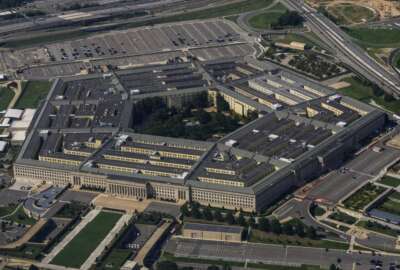Will the new defense industrial strategy actually produce results?
The latest must-read, issued by the Pentagon last week, is the first-ever National Defense Industrial Strategy. It acknowledges that America's manufacturing might...
The latest must-read, issued by the Pentagon last week, is the first-ever National Defense Industrial Strategy. It acknowledges that America’s manufacturing might isn’t what it used to be. And that it’s not really up to the task of supporting great powers competition. For one reaction, the Federal Drive with Tom Temin spoke with the executive director of the Center for Government Contracting at George Mason University, Dr. Jerry McGinn.
Interview Transcript:
Tom Temin And in your tour of duty at the Pentagon, the industrial base was your area of specialization fair?
Jerry McGinn That’s correct. That’s correct.
Tom Temin So you’ve been looking at this for a long time, and we’ve had other manufacturing and debate discussions before. Is this strategy just a admiring restatement of the problem, or is there some innovation in here?
Jerry McGinn I think there’s a benefit in kind of and this is the first of its kind to really kind of pull together all the threads of effort on the nature of the industrial base and develop a strategy. Like you said, a lot of things have been done previously, including when I was in government. And the one of the things I like about this strategy is it recognizes that it recognizes that these have been long term challenges that have developed over time and that it’s going to take time to address it. And that we’ve gone after it in a number of different ways. And I also like, I particularly like in its strategy that it recognizes the need for flexible acquisition, which I think is the most kind of fruitful thread for implementation. And then finally, I really like the fact that it recognizes the importance of allies and partners. It talks about that and how allies and partners fit within the overall industrial base, which is really good to see.
Tom Temin Right. I saw a story recently about a certain platform in a missile launching system that’s made, I think, in Finland, and it takes a couple of years to put one of these together, and they’re not in enough supply now, and they can’t ramp up a thing that takes two years to make real quickly. But yes, we do rely on European mostly suppliers as much as U.S..
Jerry McGinn That’s right. And a lot of like either subcomponents or a lot of those U.S. subsidiaries of foreign owned companies, prime systems like the Navy, forget the the Bradley fighting vehicle. These are made in the U.S., but they’re primes by non-U.S. companies technically.
Tom Temin And the strategy does mention a lot of issues, including instability of procurement, noncompetitive practices, fragility of sub tier suppliers. An economy produces what’s in demand. And for those things where there is a mixed economic need say castings and forgings, I think are mentioning in there we used to have a lot more foundries in the United States. Is that because a lot of the commercial demand has been going overseas for so long for metal parts?
Jerry McGinn Given that the way the defense market is, it’s a monopsony. You have you one customer essentially, or a series of customers. And so and the demand, when you drive GDP of that depends of GDP for defense from five and a half to three from the Cold War to today. So a lot of the business for these things goes away. And then there’s a lot of commercial items or kind of lower tier items that it is building. The demand for those is in keeping those on shore stuff. And so there’s been a lot of investment in that area, particularly in the last half decade plus to try to rebuild kind of rare earth processing capacity for castings and forgings. And a lot of money has already gone into that. And this strategy talks about that, which is great. But there’s a lot more recently with response to Ukraine as you mentioned, the kind of the inability to produce things faster that that’s where a lot of focus is going. And that’s a big focus as the strategy sets, as they increase the speed and scale of production. And that’s where I think a lot can be done going forward.
Tom Temin Yes, to increase the speed and scale of production, though, takes multiple suppliers for the most part.
Jerry McGinn Yeah. That’s right. And I think this is what I’ve kind of said and written about recently is that you can, I think there’s a lot the department can do to change behaviors in that way. It can do things like second sourcing. It can do, if possible, do dual awards of contracts to providers so that you have more supply, more kind of hot lines of producers. And you see that with the recent award on 155 munitions, they would it’s nine companies. Two of them are non-U.S. companies. So you’re building more capacity, and that’s one way that you can create more competition. But the challenge is if the demand is not there, it’s much harder to do that.
Tom Temin Right. And the report talks about that.
Jerry McGinn Yeah, exactly.
Tom Temin We’re speaking with Jerry McGinn. He’s executive director of the center for Government Contracting at George Mason University. And one of the points they make is there is limited visibility into international ally and partner requirements. That was a surprising finding.
Jerry McGinn Yeah, I think what they’re talking about there is the foreign military sale system, which is a government to government system. It’s very opaque and there’s a lot of kind of politics that’s involved in it in terms of congressional notification. So It’s really hard to get a handle on what government and foreign government needs are in advance. So it’s getting more kind of signaling that is one of the priorities that’s been identified.
Tom Temin And a lot of what they say are actions have an action plan for each of these different areas. And I’m just looking at the one under resilient supply chains, incentivize industry, manage inventory and expand support for domestic, diversify leverage data analytics. These are all kind of boilerplate prescriptions. This doesn’t sound like there’s a definite. It’s a strategy, but it doesn’t seem like a playbook yet.
Jerry McGinn That’s is a fair point. The question is now what does this lead to. Does it lead to changes in acquisition practices that help to buy more analytics? Is there investment that’s backing up these actions that’s only going to be visible when the FY25 budget request comes out in terms of investment and any kind of any specific policy or acquisition, regulatory changes to address some of the actions there.
Tom Temin And we’ve talked about this before, and this also talks about the regularity of demand signals to industry. So industry is incentivized to make the production investments it needs because it knows it has a steady demand, rotating inventories and so forth.
Jerry McGinn And that’s the key, and this is where the the government has a power as the monopsonies, that they can better exploit. Because getting to demand industry is only going to invest if they are specifically incentivized to do so through a contract action, because there’s no incentive in the market today for them to have excess capacity. They’ll get killed by their shareholders for it. So we have to think about how do you do that as the government buyer and that could be things like doing creating surge cleans where the government pays a little bit more to have industry planned for building that excess capacity if the government tells them. So that way there’s a bit more like several hundred thousand dollars for the planning, but you may be able to surge if needed in six months versus 18. So there are actions the government can take that can help create more of an incentive structure.
Tom Temin And there’s also some fine grained tuning that would need to be done to these types of efforts. Because if you’re turning out the ordinance, yeah, that’s one thing. But the platform to launch the ordinance, that’s another thing.
Jerry McGinn It’s fair. And one of the things that I’ve seen in what’s going on with the replicator initiative that Kath Hicks, the deputy secretary, is leading. And another program the Air Force is doing. They’re looking to do simpler designs, more commercially available systems, things that you can. So you don’t have to build exquisitely capable systems that take long, have to be tested a lot more fine. So they’re trying to help short circuit kind of the production timeline by doing that. You don’t do that with everything. But it’s good to see kind of the department taking that approach. And I think there’s more that I think coming down the pike.
Tom Temin Yeah. If you’re building a multiple missile simultaneous interceptor system, you can’t really simplify that. Maybe if you’re making a shell, I don’t know. There’s some components you could value analyze out of it, and turn five pieces into one casting or something.
Jerry McGinn Or you could make, frankly, you can simplify the production of the basic PGMs, precision guided munitions. So you don’t have to just hand make them essentially like the javelin and so on in ways. And that’s one of the things like the Air Force is investing. And so more of that will be important, particularly where you need things you need to scale.
Tom Temin Yeah, there was an $80,000 television set at the Consumer Electronics Show, but probably in two years it’ll be at Costco for free for 1500.
Jerry McGinn Exactly.
Tom Temin That’s kind of the idea they need there.
Jerry McGinn Very, very fair.
Tom Temin So your general assessment, tell me if you agree with this, underlying this is a department that’s worried they mentioned being able to keep up with the pacing challenge. That’s something you need to keep up with.
Jerry McGinn Yeah. No the department is very clearly worried. And one of the things that the principal author of this was Laura Taylor Calais, who’s the assistant secretary of defense for industrial based policy. One of the things she said yesterday at her rollout event was that the good thing about this, this is a very much a bipartisan effort. These are things that I saw when I was in government on both sides of the aisle. There’s a strong recognition that, it’s one of few areas where we have bipartisan consensus that we are upside down in a lot of areas with respect to Chinese threats, and we have to address that. This is a very strong call to action, and I welcome that. And I look forward to kind of working in with the implementation, because I think implementation is the key. Money is part of it, the more that invest. But a lot of that’s out of control of the department. They can propose, but then Congress disposes. But how they buy, the practices they use to design, budget, produce and contract for these systems are ways that we can speed up the process and get more things to the warfighter.
Copyright © 2025 Federal News Network. All rights reserved. This website is not intended for users located within the European Economic Area.
Tom Temin is host of the Federal Drive and has been providing insight on federal technology and management issues for more than 30 years.
Follow @tteminWFED







